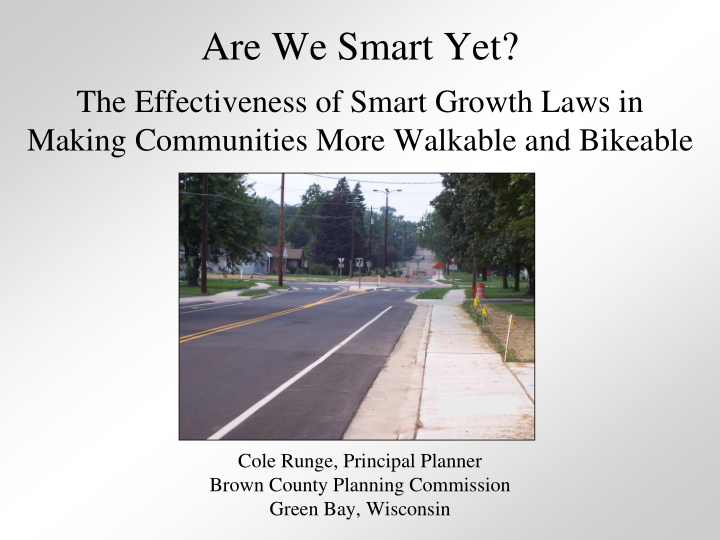



Are We Smart Yet? The Effectiveness of Smart Growth Laws in Making Communities More Walkable and Bikeable Cole Runge, Principal Planner Brown County Planning Commission Green Bay, Wisconsin
Wisconsin’s Comprehensive Planning (Smart Growth) Law signed by governor in 2000 Law crafted by: • 1,000 Friends of Wisconsin • Wisconsin Homebuilders Association • Wisconsin Realtors Association • City, village, and town representatives • State agency representatives (DOT, DNR, etc.) • University of Wisconsin system representatives • Urban and regional planners • Many others who represent a variety of backgrounds
Wisconsin’s Smart Growth Law: Requires each comprehensive plan to address nine planning elements. 1. Issues and Opportunities 2. Housing 3. Transportation 4. Utilities and Community Facilities 5. Agricultural, Natural, and Cultural Resources 6. Economic Development 7. Intergovernmental Cooperation 8. Land Use 9. Implementation
Wisconsin’s Smart Growth Law: Encourages communities, counties, and regions to achieve 14 planning goals. These include: Promotion of the redevelopment of lands with existing infrastructures and public services and the maintenance and rehabilitation of existing residential, commercial, and industrial areas. (Infill development) Encouragement of neighborhood designs that support a range of transportation choices. (Mixed land uses and variety of transportation facilities) Encouragement of land uses, densities, and regulations that promote efficient development patterns and relatively low municipal, state governmental, and utility costs. (Establish dense and efficient development patterns) Encouragement of coordination and cooperation among nearby units of government. Providing an integrated, efficient, and economical transportation system that affords mobility, convenience, and safety and that meets the needs of all citizens, including transit-dependent and disabled citizens. (Transportation for everyone)
Wisconsin’s Smart Growth Law: Provides planning grants to communities, counties, and regions that agree to meet six criteria. Each plan must: 1. Include all nine planning elements 2. Address the 14 local planning goals 3. Designate “Smart Growth Areas” where infrastructure will be directed 4. Provide many opportunities for public participation 5. Be adopted by ordinance 6. Be completed within 30 months
Wisconsin’s Smart Growth Law: Requires all cities and villages with at least 12,500 people to adopt traditional neighborhood design (TND) and conservation subdivision ordinances. TNDs feature: • Mixed land uses • Pedestrian facilities (sidewalks, trails) • Minimal building setbacks • Well-connected street patterns
Wisconsin’s Smart Growth Law: Creates a financial incentive (Smart Growth Dividend Program) for communities to implement the efficient growth patterns recommended in their plans. Idea: Smart growth results in less expensive public services, so communities and counties that grow efficiently should be rewarded.
Wisconsin’s Smart Growth Law: Requires that local land use actions be consistent with the comprehensive plan beginning January 1, 2010. Including: • Official mapping (streets, village centers, etc.) • Subdivision regulation (sidewalk requirements, etc.) • Extraterritorial plat review (ensure that sidewalk, bike facilities continue across municipal boundaries, etc.) • Zoning ordinances and amendments • Improvements to certain transportation facilities (when economic benefits can be expected) • Land acquisition for recreational lands and parks
Six Years Later… • The nine planning elements continue to be required • The 14 planning goals are still intact • The planning grants continue to be available *Governor vetoed legislature’s attempt to eliminate funding last year • The TND and conservation subdivision ordinances are still required *Existing PUD/PDD zoning codes can be used instead • The Smart Growth Dividend Program was never funded • Plan deadline still January 1, 2010 *Attempts have been made to eliminate the law (failed in legislature) *Number of required actions significantly reduced by legislature Official mapping, subdivision regulation, zoning codes & amendments
Six Years Later in Brown County… Smart Growth plans have been completed for county and 19 of county’s 24 communities. First plan completed and adopted in September of 2002, last four started in June of 2006. Many plans talk the talk, but are communities walking the walk? It varies from place to place.
Village of Howard before Smart Growth plan… Was primarily a bedroom community for Green Bay The village’s wide streets, few sidewalks, and very little mixing of land uses = community where walking and biking were difficult and unappealing for many people
…and after Smart Growth plan Mixed-use village center plan developed after Smart Growth plan was completed
Village of Howard after Smart Growth plan Narrower streets recommended in plan Three-step sidewalk installation policy recommended in plan
Village of Howard after Smart Growth plan Step 1: Install sidewalks in all new subdivisions Sidewalks continue in front of undeveloped lots Sidewalks required on both sides of street
Village of Howard after Smart Growth plan Step 2: Install sidewalks along major streets and walk routes New sidewalks along arterial street that connects several neighborhoods to three schools
Village of Howard after Smart Growth plan Step 3: Construct sidewalks along the rest of the village’s streets by identifying demand and consulting residents prior to street reconstruction projects Existing neighborhood retrofitted with sidewalks These improvements would not have likely been possible without the “in” granted to us by the Smart Growth law.
Unfortunately, many plan recommendations are not implemented… Plans still viewed by many people as mere guides Some recommendations are implemented, some aren’t A plan that recommends sidewalks might not result in sidewalks Bottom line: The laws help to create pedestrian and bike plans , but they don’t necessarily create comprehensive pedestrian and bike systems . We won’t likely have a true idea of the Wisconsin law’s effectiveness until after January 1, 2010
Have Smart Growth laws made communities more walkable and bikeable? I believe Wisconsin’s law has. Why? Wisconsin’s law requires communities, counties, and regions to at least consider walking and bicycling as plans are being developed. Law opens door for discussions about creating pedestrian and bicycling systems that people can and want to use. - Land use patterns - Lot designs - Pedestrian and bicycle facilities - Barrier minimization (cul-de-sacs, multi-lane streets, etc.) Process used to create Smart Growth plan creates several opportunities for education about the benefits of improving walking and bicycling conditions.
Want more information? Check out our website www.co.brown.wi.us/planning
Questions or Comments?
Recommend
More recommend